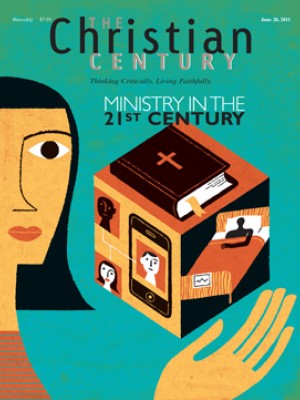Detour to mission: An unplanned ministry

A church's strategic planning process is a fragile creature. Like those Hebrews who were on a desert journey, we're not sure where we are going. We hope that we will end up not with some golden idol of a vision, but with God relentlessly guiding us along the way with a fiery pillar.
When the church I serve undertook a strategic planning process in 2005, there was more golden calf than fiery pillar. Like many such efforts, it produced an earnest, businesslike plan. We held conversations within our church community, gathered demographic data on ourselves and our neighborhood and reflected on all of this with a consultant. The vision statement that emerged included a list of 20 bullet points, objectives for the coming years, metrics for evaluation and job descriptions for the staff.
Read our latest issue or browse back issues.
We declared, "As a congregation God is calling us to grow in diversity, foster, celebrate and accommodate growth in membership, support one another on our journeys of faith, enrich our community life, advance our work of social justice, all with the help of our finances, staff, facility and laity." Maybe the fact that the vision statement was a rambling sentence should have alerted us to trouble ahead.
In retrospect the vision statement fit our bubble economy perfectly: it assumed that God was calling us to have more, as in more diversity, more people, more programs, more of everything. The statement reflected our activist liberal bent, but in its own way it was not far from the prosperity gospel.
About the time we finished our vision statement, city alderman Nik Kovac came to ask if we could help Pathfinders, a shelter for homeless young people, expand its work by providing a youth drop-in center. Kovac thought that the church might be a good location for the agency's new drop-in center, or that at least we might be people who would get involved.
A survey focusing on youth reported that on any given night in Milwaukee, 400 youth are homeless. Not all of these youth sleep under bridges; most are housing-insecure, meaning that they hop from couch to couch, friend's house to friend's house. This mobility often places them in dangerous situations. Interviews with homeless youths revealed that two-thirds engage in "survival sex," trading sex for housing or food or slipping into habitual prostitution. Despite the great need, our county had only 16 beds in safe shelters available for homeless youth. God's fiery pillar came to us in an alderman's plea to help this vulnerable and often hidden population.
The idea of becoming a home to a homeless youth drop-in center was not on the radar of our strategic-planning process. Still, in the fall of 2008 we agreed to think about it, and soon we'd said yes—without a clear idea of what yes might mean.
It soon became obvious that our congregation could not provide Pathfinders with the number of rooms and offices that the organization needed for a drop-in center. But a better option came along. While the new center was being built, we could hold youth meetings for Pathfinders at the church and invite the youth to church events.
Suddenly youth homelessness was connected to a face instead of a statistic. We met Ajay, whose mother had fled a toxic family situation; he became homeless because the shelters for women and families in our city do not take 17-year-old boys. We met Kendra, who was not homeless but in crisis with her family because of her sexual-identity issues.
In the fall of 2009, we received an emergency call: Pathfinders had to vacate an office building that it was using for counseling. This agency for homeless youth was suddenly homeless itself as it waited for its new center to be built. Could the church help out? We said yes. Social workers turned the church's parlor and back rooms into counseling and group therapy spaces. A carefully laid-out schedule allowed the church staff and Pathfinders staff to work around each other. Church members, therapists and clients made do with this ad hoc arrangement.
When Pathfinders finally moved into its new drop-in center, I thought the youths would want to stop meeting at the church; after all, we didn't have Wi-Fi and computers. Instead they asked if they could meet twice a week instead of twice a month, and 30 young people showed up instead of ten. Our church members provided food, taught classes and stopped in to visit with the teens.
About this time we had a funeral. Virginia had once been an active member of the congregation, and at her funeral the story of her life emerged. We learned that 40 years ago, a group of university students had wanted to help runaway youths on Milwaukee's streets, but an obstacle stood in their way: the law prohibited the harboring of runaways. Virginia used her position at the state welfare agency to broker an arrangement between the students, police and families willing to shelter youths temporarily. The church hosted a call center that connected young people with help and relayed messages back and forth with their estranged families. These efforts became the nucleus of Pathfinders.
Our congregation's ministry to teens was not new after all but was connected to Virginia's initiative. I saw a path winding back to the spiritual ancestors of the congregation: the 1920s members who built a gymnasium for youth in the neighborhood, and the 1870s members who organized clubs for the immigrant children on the streets. God's fiery pillar had taken us on a journey that restored our core identity.
One night my family prepared and served the meal for the youths in the church. I brought a blueberry cobbler, a favorite dessert in our house, but I had underestimated the turnout. Clearly there was not going to be enough cobbler for all. Dan, one of the regulars, was delighted to see the dessert. Skipping dinner, he took a huge serving of it. After one bite he said he couldn't eat it all but asked for a container to wrap it up in.
Normally I'd be annoyed when one individual took so much that others wouldn't have any. It was different with Dan. I knew he never ate in front of other people; he always wrapped food up to eat when he was alone. What happens in a kid's life to make it seem unsafe to eat in the presence of other people?
Our church didn't save all the homeless youth in our county, but we did make a difference in the lives of Dan, Ajay, Kendra and others. Members are planning more for the teens, including classes in yoga and lessons in photography and music. Saying yes to helping Pathfinders has certainly interrupted and altered our strategic plan. But by taking this detour we have come to embody what we first envisioned in 2005—more diversity, more youth programming, more outreach.
We planned. God summoned. We thought of golden calves, while God lighted up a fiery pillar and led us in another direction.






